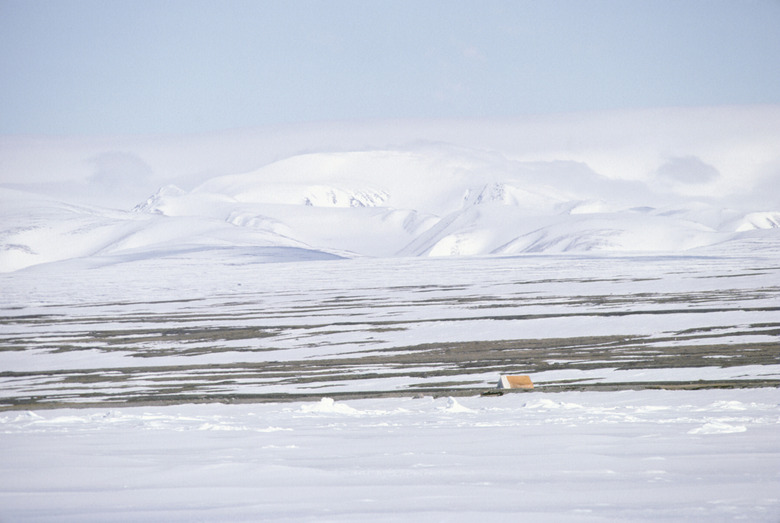Tundra Characteristics
The term tundra refers to a barren, treeless biome with very little precipitation. The tundra is covered with snow for most of the year and has a short growing season. Very few living organisms make their home in the tundra due to the harsh environment. The word tundra comes from the Finnish word "tunturi," which means treeless plain.
Two Types of Tundra
Two Types of Tundra
There are two types of tundra: Arctic tundra and alpine tundra. The Arctic tundra is located within the Arctic Circle and lacks trees due to the presence of permafrost and the short growing season. Alpine tundras are located above the tree line on mountainsides around the world. Alpine tundras lack trees due mainly to their high elevation.
Tundra Climate
Tundra Climate
The climate of the tundra is very similar to that of a desert in that it is very dry and windy and can experience extreme temperatures. The main difference between the tundra and the desert is the temperature. While a desert is usually hot, average temperatures on the Arctic tundra range between -25 degrees Fahrenheit and 40 degrees Fahrenheit. The alpine tundras are slightly warmer with average temperatures ranging between zero degrees Fahrenheit and 54 degrees Fahrenheit.
During the summer, the tundra experiences a short period of lukewarm temperatures that make it possible for living things to thrive. The alpine tundra has a growing season of approximately 180 days, while the Arctic tundra has a shorter growing season of 50 to 60 days. During summer in the Arctic tundra the permafrost melts partially. This temporary thaw creates bogs and ponds on top of the permafrost that provide necessary habitat for many living things such as birds and insects.
Permafrost
Permafrost
Permafrost refers to the perpetually frozen layer of soil and other organic material that exists within the Arctic Circle. It is one of the defining characteristics of the Arctic tundra and is one of the main reasons why trees cannot thrive in the tundra. In many places the permafrost extends hundreds if not thousands of feet below the surface of the ground. The thawing and freezing of the permafrost is a crucial component of the tundra ecosystem.
Tundra Precipitation
Tundra Precipitation
An important characteristic of the tundra is the dry climate. Total precipitation on the tundra averages less than 15 inches per year, with two-thirds of the total falling as rain. A true desert typically receives no more than 6 to 10 inches of precipitation per year.
Tundra Plants and Animals
Tundra Plants and Animals
There are relatively few species of organisms that can survive in an environment like the tundra. Humble, low-lying perennial plants provide food for the unique community of animals that live there. Typical tundra plants include lichen, moss, sedges, grass and shrubs. Trees are very scarce.
The tundra is colonized by a variety of insects and birds as well as a handful of larger animals. The alpine tundras are typically home to marmots, sheep and mountain goats, while the Arctic tundra is the habitat of animals such as the Arctic fox, musk oxen, snow geese, gray wolves and polar bears.
The Land of the Midnight Sun
The Land of the Midnight Sun
The Arctic tundra is home to the phenomenon that many people refer to as the midnight sun. During the summer months in the Arctic Circle, the sun does not completely disappear below the horizon. Alternatively, during the winter months there is a period of time when the sun does not rise above the horizon at all. This creates periods of 24 hours of sunlight in summer and 24 hours of darkness in winter.
The conditions created by the 24 hours of dark in winter and 24 hours of light in the summer are vastly different to the conditions located at Earth's equator. People and other organisms that live near the equator experience more or less the same schedule of light and dark throughout the year, and the periods of day and night are equal – about 12 hours of each.
Countries that experience the midnight sun phenomenon include Norway, Finland, Iceland, Greenland, Denmark, Sweden, Russia and Canada. Alaska in the United States also experiences the midnight sun.
Cite This Article
MLA
Reinbold, Joan. "Tundra Characteristics" sciencing.com, https://www.sciencing.com/tundra-characteristics-6817564/. 24 June 2019.
APA
Reinbold, Joan. (2019, June 24). Tundra Characteristics. sciencing.com. Retrieved from https://www.sciencing.com/tundra-characteristics-6817564/
Chicago
Reinbold, Joan. Tundra Characteristics last modified August 30, 2022. https://www.sciencing.com/tundra-characteristics-6817564/
